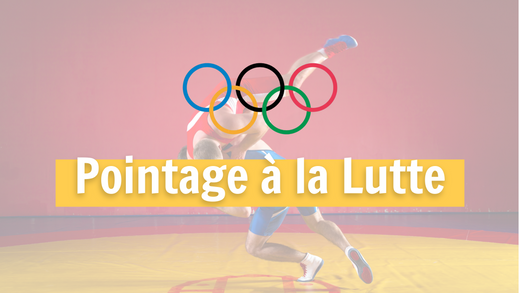
Olympics: How to Score Points in Olympic Wrestling
Pascal CadoretteThis is how points are counted in Olympic wrestling
Are you starting to watch Olympic wrestling and wondering how the points and penalty system works and want to quickly understand how points are counted in Olympic wrestling?
So, in this article, you will find EXACTLY what you need to understand everything about the scoring and penalty system to better understand Olympic wrestling and encourage your favorite athletes.
Olympic wrestling is a sport where scoring is essential to determine the winner of a bout. According to the rules of wrestling, points are awarded based on actions performed by each wrestler, such as holds, throws, and immobilizations.
Each action is evaluated by the referees and awarded a certain number of points. For example, a successful throw can be worth two points, while an immobilization can be worth five points. The points accumulated during the fight determine the winner.
Now, let's dive into the concrete and the details to better understand the Olympic wrestling scoring system.
What is Olympic wrestling ?
Olympic wrestling is a combat sport that pits two opponents against each other seeking to defeat each other through holds and immobilizations. It is a similar sport, but different from Olympic Judo since here, some holds are also included in addition to projections and immobilizations.
It is one of the oldest disciplines of the Olympic Games, dating back to antiquity. Modern Olympic wrestling is divided into different weight categories and is practiced in two main styles: freestyle wrestling and the Greco-Roman wrestling .
Olympic wrestling is a demanding sport that combines strength, agility and technique. Wrestlers must be able to demonstrate strategy, speed and power to score points and win the bout.
Each fight takes place on a mat specially marked for wrestling and which includes 3 distinct zones:
-
The central wrestling area is a dark blue circle of 7m in diameter in which the wrestlers must stay. In the center is drawn a circle of 1m in diameter, this is where the fight begins.
-
The Passivity Zone is a 1m wide orange band all around the central area. You have to be careful in this area, since a wrestler who enters it risks a penalty.
-
Central surface and passive zone jointly form the combat zone with a total diameter of 9m.
- The protective surface , in blue, is located on the edge of the mat. As soon as you enter this area, the fight stops and the wrestlers must start again in the center of the combat zone. This area is out of bounds.

The Basic Rules of Olympic Wrestling
Olympic wrestling is a combat sport in which two wrestlers compete on a circular wrestling mat. The rules of Olympic wrestling are based on the International Wrestling Rules .
The goal is to score points by performing holds, throws and immobilizations on your opponent. The wrestler who scores the most points within 2 rounds of 3 minutes each or manages to immobilize his opponent wins the fight.
A wrestler can also win by technical superiority before the end of the fight or if he reaches 10 points difference with his opponent, within 2 rounds.
If there was no immobilization or the points are equal, the winner will be the wrestler who received the fewest warnings or penalties. If there is a tie, the winner will be chosen according to the one who performed the action with the highest value or, finally, the one who scored last.
In order to keep the wrestlers active, a passivity rule keeps the fight active.
Different penalties may be applied:
-
In Greco-Roman wrestling: for the first 2 passivities, the fight is simply stopped and the active wrestler receives 1 pt. The active wrestler can choose between a parterre or standing position to resume the fight. From the 3rd passivity, the active wrestler receives 1 pt without stopping the fight.
- In freestyle wrestling or women's wrestling: An insufficiently active wrestler receives a 1st verbal warning from the referee. At the 2nd penalty, an additional timer called the "Shot Clock" lasts 30 seconds and forces the passive wrestler to score points. To force the passive wrestler to become more active. If he does not score during the "Shot Clock" 1 point is awarded to the active wrestler.
The basic rules of Olympic wrestling include restrictions on finger holds, strikes, and unsportsmanlike behavior. Wrestlers must also respect the boundaries of the wrestling mat and not leave the combat area. Referees enforce the rules and award points based on the actions performed by the wrestlers.
Points in Olympic Wrestling
During the wrestling match, 3 referees monitor the match, 2 of which are outside to monitor the match.
Points are awarded based on the quality of the techniques, but also on the strength, amplitude and level of danger the wrestler is in. The more the wrestler's back is facing the ground, the more danger he is considered to be in.
Here are the different points during an Olympic Wrestling match:
- 1 Point: Exit from the mat on an offensive action or a fall.
- 2 Points: The wrestler is brought to the ground (unbalance of the standing opponent causing him to fall flat on his face with a controlled hold) or the wrestler has turned his opponent over on the ground, exposing his back to the mat.
- 4 Points: Successful throws that bring the opponent to the ground directly on their back.
- 5 Points: High-amplitude throws that bring the opponent to the ground directly on their back.
As soon as a wrestler reaches a 10-point gap with his opponent, he wins the fight.
Conclusion and resources for learning Olympic wrestling
Olympic wrestling is a beautiful sport that can happen very quickly and can become very spectacular. By understanding the rules and techniques of Olympic wrestling, you will be able to enjoy this sport more during Olympic competitions and cheer on your favorite athletes during fights!
If you are interested in learning more about Olympic wrestling, there are many resources available to further your knowledge. Local wrestling clubs, sports federations, and specialized websites are all great sources of information and learning.









